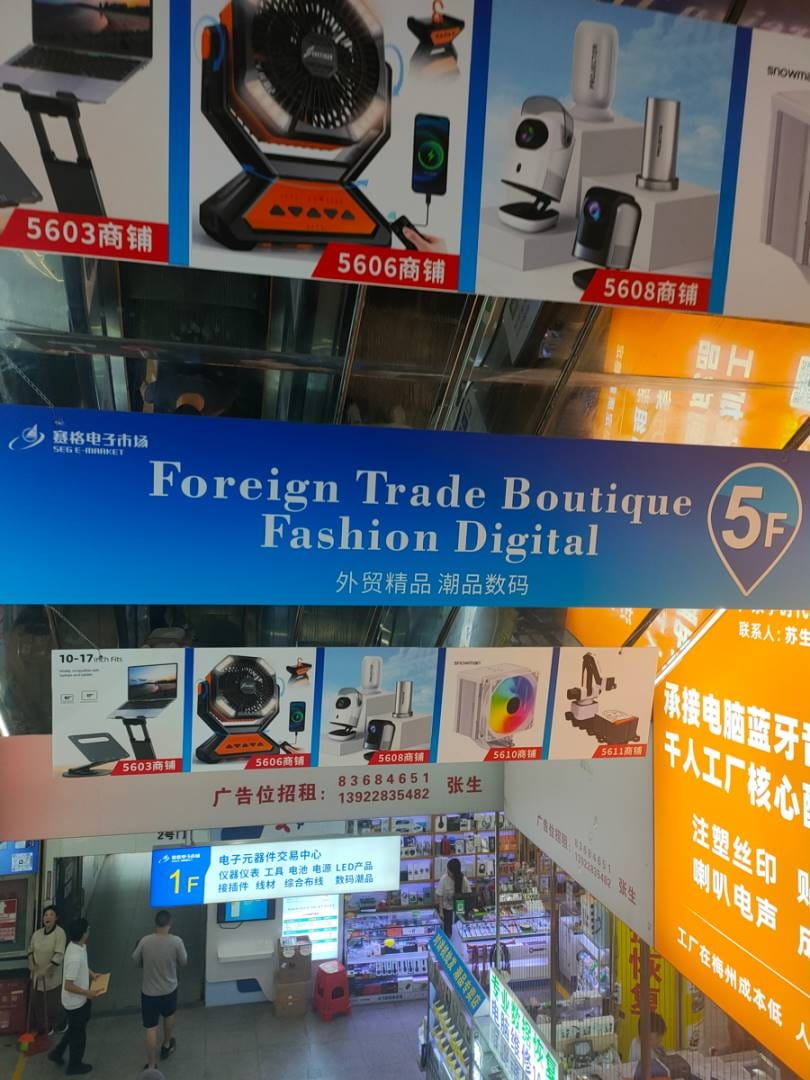Written by: Cao Yuan, 21st Century Economic Report
In the current foreign trade business, more and more merchants are noticing the use of stablecoins for cross-border payments.
Earlier, reporters from the 21st Century Economic Report went to Yiwu, 'the world's largest small commodity distribution center', to investigate merchants' use of stablecoins and found that most merchants reported they had never heard of stablecoins and did not understand them; some merchants raised questions about their compliance, costs, etc.; only a few merchants supported stablecoin payments.
In China's 'Electronic First Street' Shenzhen Huaqiangbei, there is a vast electronic component trading market, which also attracts numerous suppliers and buyers from around the world.
Recently, the reporter also visited five malls in Shenzhen Huaqiangbei, including Seg Electronics Mall, Seg Communication Market, Modern Window Digital Plaza, Yuanwang Digital Mall, and Longsheng Accessories City, visiting dozens of merchants across different malls. The reporter also consulted more than 20 Huaqiangbei merchants online to explore their stablecoin transaction situation: only a few merchants said they would use or try to use stablecoins for transactions, while most merchants said they were not familiar with stablecoins.
Stablecoins refer to a type of cryptocurrency that is pegged to fiat currency. Taking the currently largest stablecoin USDT as an example (commonly referred to as 'U'), 1 USDT is pegged to 1 US dollar. This year, driven by legislative progress in the United States and Hong Kong, the stablecoin sector is experiencing a surge globally.

China's 'Electronic First Street' Shenzhen Huaqiangbei (Photo / Cao Yuan)
Some merchants expressed their intention to 'test the waters'
During the visits by reporters from the 21st Century Economic Report, some merchants in Huaqiangbei stated they would use or try to use stablecoins for transactions. One merchant dealing in 3C electronic products said, 'Some people around me are using stablecoins for trading. I would consider using stablecoins for overseas payments, but I haven't completed any transactions yet.'
In addition to offline visits, the reporter also randomly consulted more than 20 Huaqiangbei merchants on online platforms, among which two said they could accept stablecoins. Another stablecoin exchange merchant told the reporter online, 'Some foreigners ask if they can pay with stablecoins because it's convenient.'
Most of the interviewed Huaqiangbei merchants said, 'We do not know what stablecoins are.' Even if some merchants have heard of stablecoins, they believe it is unrelated to their daily operations.
A merchant specializing in hair dryers said, 'Currently, many foreigners still mainly pay with cash or Alipay when shopping. My recent larger overseas remittance was 30,000 US dollars, which someone helped me transfer through Alipay.'
Another CPU merchant said, 'We only use legal currency, and have never used stablecoins.' A merchant dealing in graphics cards asked the reporter, 'Is a stablecoin the same as Bitcoin? What use is it to me?'
The reporter consulted relevant staff from two malls in Huaqiangbei, who also stated, 'As far as I remember, it seems that no merchants use stablecoins. I will look into it further.'

Huaqiangbei Seg Plaza (Photo / Cao Yuan)
Even if some merchants intend to use stablecoins for payments, the next step of 'cashing out' stablecoins is still a gray area, generally conducted through so-called 'U merchants'. 'U merchants' refer to virtual currency exchange merchants or OTC (over-the-counter) merchants in the cryptocurrency circle. They mainly earn profit margins by providing exchange services between the stablecoin USDT (commonly referred to as 'U') and fiat currency in the virtual currency trading market.
The reporter's investigation found that different 'U merchants' set various transaction thresholds for 'receiving U', mainly focusing on 'large transactions'. One 'U merchant' directly told the reporter, 'We only do large transactions for 'receiving U', starting from fifty thousand U. The received coins can be in thousands.' (i.e., starting from fifty thousand stablecoins USDT, paid in cash). However, another 'U merchant' who learned the reporter had a need to 'cash out U' said, 'You can come for offline transactions.'
In terms of exchange rates, taking USDT as an example, 1 USDT is pegged to 1 US dollar, so most 'U merchants' will offer a slightly lower rate on the day to 'receive U', with some 'U merchants' also charging certain fees. 'Lower than the market price for receiving, higher for selling.' One 'U merchant' explained his 'receiving U model' to the reporter in simple terms. Another 'U merchant' calculated, 'I don't have a price list; it's all a unified price. For example, if I receive 100 stablecoins worth 100 US dollars from you, I can give you 97 US dollars in cash, and the fee for each coin is 0.03 yuan (RMB).'
And who are the downstream 'U merchants', who will 'take over' the stablecoins they receive? The aforementioned 'U merchant' told the reporter, 'Some of us will sell them on exchanges, and some peers will also need to receive them.'
Need to guard against compliance risks
Have some merchants noticed stablecoins, even using stablecoins for foreign trade?
Known as 'stablecoin concept stocks', Tianyang Technology summarized in response to investor questions that first, the arrival time is uncertain and depends on the design of the counterparty's bank link in SWIFT; second, the fees are opaque, depending on the intermediary banks involved; third, the transaction status, although SWIFT has launched a service to pay for tracking transaction status, currently the funding progress is not known to either the remitter or the payee.
Stablecoins have certain advantages in cross-border payment settlements. 'The biggest difference between stablecoins and other virtual currencies is that they are pegged to fiat currency, making them relatively stable, which reduces their financial investment attributes and highlights their monetary settlement attributes.' A person from a bank's transaction banking department told the reporter, 'Stablecoins bypass the traditional SWIFT banking system, achieving peer-to-peer transactions on the blockchain network. However, it is currently illegal in mainland China.'
However, it should be noted that using stablecoins for foreign trade settlements in the country faces compliance risks.
'Currently, using virtual currency for cross-border payments domestically is definitely not feasible.' Zeng Jie, a senior partner at Guangqiang Law Firm and director of the Illegal Fundraising Defense and Research Center, emphasized to the reporter. Recently, relevant departments in Shenzhen and Beijing also issued risk alerts: beware of illegal fundraising under the guise of stablecoins and other names.
In addition, regarding the transactions of 'receiving U and cashing out U', Zeng Jie believes that this is actually a qualitative issue regarding virtual currency trading itself. If an individual's virtual currency trading investment conforms to public order and good customs, it is merely personal investment trading, not related business activities. The transaction itself is a transaction of virtual goods, which is protected by law.

